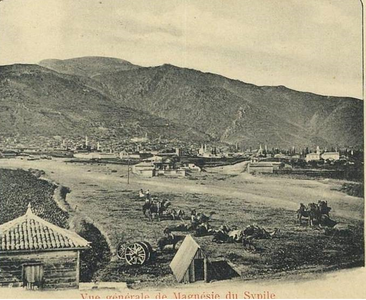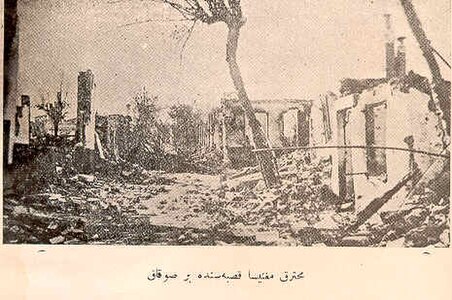Incendie de Manisa
L'incendie de Manisa en Anatolie a eu lieu entre le 5 et le [1],[2],[3],[4],[5], pendant la guerre gréco-turque de 1919-1922.
Déroulement et dégâts
La ville a été brûlée lors du retrait des troupes grecques[6]. Plus de 90 % de la ville a été détruite, soit environ 10 000 bâtiments[7],[8]. La population de la ville avant l'incendie se situait entre 35 000[9] et 50 000 habitants[10]. Les pertes économiques s'élèvent à plus de 50 millions de lires[11]. Les autorités turques affirment que 4 355 personnes sont mortes lors de cet évènement[11].
Épilogue
L'événement est cité dans la littérature turque, comme par exemple, chez Ilhan Berk et Falih Rıfkı Atay.
Henry Franklin-Bouillon a été témoin du ravage qu'a provoqué cet incendie[12].
Le vice-consul des États-Unis James Loder Park a visité la ville détruite[Quand ?].
-
Vue générale avant l'incendie. -
Une image d'une rue après l'incendie.
Notes et références
- ↑ « Manisa incendie »
- ↑ « Manisa brule »
- ↑ « Turquie »
- ↑ « Manisa brule »
- ↑ (en) Feridun Mustafa Emecen, Tarihin içinde Manisa, Manisa Belediyesi, , 268 p. (ISBN 978-975-95506-0-8), p. 6
« Yunan kuvvetleri çekilirken 5 Eylül Sali günü sehri atese verdiler, aksam söndürülen yangin sabah çarsi kesiminde tekrar basladi ve 8 Eylül'de kendiliginden söndü. Yangin sirasinda halk daglara kaçti, bu büyük yangin neredeyse sehrin tamamini etkiledi, 10.700 ev, on üç cami, 2728 dükkân, on dokuz han yandi, Manisa tam bir harabeye dönüstü. 8 Eylül’de Türk birlikleri Manisa yakinlarindaki küçük bir çarpismanin ardindan sehre girdi. Cumhuriyet döneminde bu tahribatin izleri kapandi ve sehir yeniden gelismeye basladi. (en) "The Greek forces, while retreating, set the city on fire on 5 Tuesday, September it was extinguished in the evening but began again the following morning in the market sector and on 8 September was extinguished by itself. During the fire the people fled to the mountains, this great fire affected almost the entire city, 10,700 houses, thirteen mosques, 2,728 shops and nineteen inn were burned, Manisa became a complete ruin. On 8 September after a minor collision near Manisa, the Turkish troops entered the city. In the Republican period, the traces of this destruction disappeared, and the city began to flourish again. " »
- ↑ (en) John Freely, Children of Achilles : the Greeks in Asia Minor since the days of Troy, Londres, .B.Tauris, , 268 p. (ISBN 978-1-84511-941-6, lire en ligne), p. 212
« Manisa, which was burned to the ground by the Greeks when they evacuated the town. »
- ↑ (en) Rosie Ayliffe, Turkey, Rough Guides, , 1119 p. (ISBN 978-1-84353-071-8, lire en ligne), p. 313
« Later, the Ottomans sent heirs to the throne here (Manisa) to serve an apprenticeship as local governors, in order to ready them for the rigours of Istanbul palace life… Over ninety percent of the historic centre was destroyed by the Greek army during its 1922 retreat. »
- ↑ U.S. Vice-Consul James Loder Park to Secretary of State, Smyrna, 11 April 1923. US archives US767.68116/34
Consul Park concluded:
« 1. The destruction of the interior cities visited by our party was carried out by Greeks. »
« 2. The percentages of buildings destroyed in each of the last four cities referred to were: Manisa 90 percent, Cassaba (Turgutlu) 90 percent, Alasehir 70 percent, Salihli 65 percent. »
« 3. The burning of these cities was not desultory, nor intermittent, nor accidental, but well planned and thoroughly organized. »
« 4. There were many instances of physical violence, most of which was deliberate and wanton. Without complete figures, which were impossible to obtain, it may safely be surmised that 'atrocities' committed by retiring Greeks numbered well into thousands in the four cities under consideration. These consisted of all three of the usual type of such atrocities, namely murder, torture and rape. »
« Cassaba (present day Turgutlu) was a town of 40,000 souls, 3,000 of whom were non-Muslims. Of these 37,000 Turks only 6,000 could be accounted for among the living, while 1,000 Turks were known to have been shot or burned to death. » - ↑ (en) United States. Dept. of State, Papers Relating to Foreign Affairs, 3, U.S. Government Printing Office, (lire en ligne), p. 311
« this is a florishing city of about 35,000 inhabitants, about one-fourth of whom are Greeks and Armenians »
- ↑ (en) Charles Kendall Adams, Johnson's universal cyclopaedia, Volume 8, A.J. Johnson Co, (lire en ligne), p. 310
- (en) Teoman Ergül, Kurtulus Savasinda Manisa, 1919-1922, Manisa Kültür Sanat Kurumu, (lire en ligne), p. 337
« Daha acisi 3500 kisi ateste yakilmak ve 855 kisi kursunlanmak suretiyle öldürülmüstü. Üç yüz kizin irzina geçilmisti. Sadece bir mahalleden 500 kisi götürülmüstü. Ölü veya diri olduklari hakkinda bir bilgi alinamamistir. (en) "The more painful, that 3500 people were burned to death and 855 people were shot dead. Three hundred girls were raped. From only one district, 500 people were taken away. Their fate was unknown."… 10700 ev, 13 cami, 2728 dükkan, 19 han, 26 bag kulesi, 3 fabrika, 5 çiftligin yanmasi ile 50 milyon olarak saptanmisti… (fr) "de cinquante millions de dommages et intérêts… que 3500 personnes ont été brûlées à mort et 855 personnes ont été tuées." »
- ↑ « Turks halt embarkation of all Smyrna refugees; Quit the neutral zone », Rome Daily Sentinel (consulté le ) : « visiting the areas devastated by the Greeks. He declared that out of 11.000 houses in the city of Magnesia only 1.000 remained »


